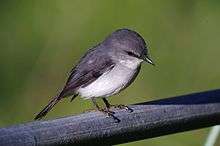White-breasted robin
| White-breasted robin | |
|---|---|
 | |
| In Western Australia | |
| Scientific classification | |
| Kingdom: | Animalia |
| Phylum: | Chordata |
| Class: | Aves |
| Order: | Passeriformes |
| Family: | Petroicidae |
| Genus: | Eopsaltria |
| Species: | E. georgiana |
| Binomial name | |
| Eopsaltria georgiana (Quoy & Gaimard, 1830) | |
| Synonyms | |
|
Quoyornis georgiana | |
The white-breasted robin (Eopsaltria georgiana) is a species of bird in the family Petroicidae. It is endemic to southwestern Australia. Unlike many other Australian robins, it lacks bright colours in its plumage, being a predominantly greyish bird with white underparts. Like many other Australian passerines of the Corvida group, it is a cooperative breeder. It is sedentary, with pairs or small groups maintaining territories.
Taxonomy
The white-breasted robin was first described by the French naturalists Jean René Constant Quoy and Joseph Paul Gaimard in 1830 as Muscicapa georgiana.[2] It was later described in its current genus by John Gould in 1846 as Eopsaltria leucogaster,[3] though as the former took precedence its specific name remains georgiana. Like all Australian robins, it is not closely related to either the European robin or the American robin, but belongs rather to the Corvida parvorder comprising many tropical and Australian passerines including pardalotes, fairy-wrens and honeyeaters as well as crows. It belongs to the genus Eopsaltria, whose Australian members are known colloquially as "yellow robins" as distinct from the "red robins" of the genus Petroica. This species has also been known as the white-bellied robin and white-breasted shrike-robin.[4]
A 2009 genetic analysis of nuclear and mitochondrial DNA has unexpectedly placed the white-breasted robin as sister taxon to the two Tregellasia robins native to northeastern Australia.[5]
It was known as boydjil by the local indigenous people of Augusta.[6]
Description
The white-breasted robin is 14.5 cm (5 3⁄4 in) long. Males and females are similar in coloration, with blue-grey upperparts, paler eyebrows, and whitish underparts. The grey tail is tipped with white. Bills and feet are black in colour, while eyes are dark brown. Birds from the northern part of its range are smaller and darker grey in colour. Juveniles are brownish.[7]
Distribution and habitat
The white-breasted robin is found in Western Australia south from Geraldton to the southwest corner of the continent. In the southern part of its range, the white-breasted robin frequents open forest, often near rivers. It prefers coastal scrub in the north.[7] It is sedentary, with pairs or small groups maintaining territories in its range.
Behaviour

Like many other members of the Corvida, the white-breasted robin is a cooperative breeder; breeding pairs are often assisted by one or more helper birds who help raise young.[8] Helper birds are mostly male; female birds are more likely to leave the territory in the first year of their life, while males are more likely to remain.[8]
Breeding
Breeding season is late winter to early summer with up to two broods raised. The nest is a neat cup made of dry grass and bark. Spider webs, generally located in a tree fork in dense scrub close to a watercourse.[9] Two pale olive- to blue-green eggs, often splotched with a darker variant of the background colour, are laid. They measure 16 mm x 21 mm, and one is often much paler than the other.[10] Incubation lasts 16 or 17 days, with young leaving the nest two weeks after hatching.[8]
References
- ↑ BirdLife International (2012). "Eopsaltria georgiana". IUCN Red List of Threatened Species. Version 2013.2. International Union for Conservation of Nature. Retrieved 26 November 2013.
- ↑ Quoy, J.R.C. & Gaimard, J.P. in Dumont-d'Urville, J. (1830). Voyage de découvertes de l'Astrolabe exécuté par ordre du Roi, pendant les anneés 1826-1827-1828-1829, sous le commandement de M.J. Dumont-d'Urville. Zoologie. Paris: J. Tastu Vol. 1
- ↑ Gould J (1846). "Descriptions of eleven new species of Australian birds". Proc. Zool. Soc. Lond.: 18–21.
- ↑ Boles, Walter E. (1988). The Robins and Flycatchers of Australia. Sydney: Angus & Robertson. p. 119. ISBN 0-207-15400-7.
- ↑ Loynes, Kate; Joseph, Leo; Keogh, J. Scott (2009). "Multi-locus phylogeny clarifies the systematics of the Australo-Papuan robins (Family Petroicidae, Passeriformes)". Molecular Phylogenetics and Evolution. 53 (1): 212–19. PMID 19463962. doi:10.1016/j.ympev.2009.05.012.
- ↑ Abbott, Ian (2009). "Aboriginal names of bird species in south-west Western Australia, with suggestions for their adoption into common usage" (PDF). Conservation Science Western Australia Journal. 7 (2): 213–78 [263].
- 1 2 Simpson K, Day N, Trusler P (1993). Field Guide to the Birds of Australia. Ringwood, Victoria: Viking O'Neil. p. 392. ISBN 0-670-90478-3.
- 1 2 3 Russell EM, Brown RJ, Brown MN (2004). "Life history of the white-breasted robin, Eopsaltria georgiana (Petroicidae), in south-western Australia". Australian journal of zoology. 52 (2): 111–45. doi:10.1071/ZO03049.
- ↑ Cooney SJN, Watson DM, Young J (2006). "Mistletoe nesting in Australian birds: a review" (PDF). Emu. CSIRO Publishing. 106: 1–12. doi:10.1071/MU04018. Retrieved 2007-06-07.
- ↑ Beruldsen, G (2003). Australian Birds: Their Nests and Eggs. Kenmore Hills, Qld: self. pp. 336–37. ISBN 0-646-42798-9.
External links
| Wikimedia Commons has media related to Eopsaltria georgiana. |
